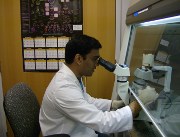MU Scientists Convert Pigs' Connective Tissue Cells into Stem Cells
New finding could result in better tests for stem cell therapy, more accurate model
June 25, 2009
Story Contact: Christian Basi, (573) 882-4430, BasiC@missouri.edu
COLUMBIA, Mo. - For years, proponents have touted the benefits of embryonic stem cell research, but the potential therapies still face hurdles. Side effects such as tumor development, a lack of an effective and long-term animal model to test new therapies, and genetic incompatibility between the host and donor cells are some of the problems faced by researchers. Now, scientists at the University of Missouri have developed the ability to take regular cells from a pig's connective tissues, known as fibroblasts, and transform them into stem cells, eliminating several of these hurdles. The new study appeared in a recent issue of the Proceedings of the National Academy of Science (PNAS).
"It's important to develop a good, accurate animal model to test these new therapies," said R. Michael Roberts, Curator's Professor of Animal Science and Biochemistry and a researcher in the Bond Life Sciences Center. "Cures with stem cells are not right around the corner, but the pig could be an excellent model for testing new therapies because it is so similar to humans in many ways."
In their research, Roberts; Toshihiko Ezashi, a research assistant professor of animal sciences in the College of Agriculture, Food and Natural Resources and lead author on the study; and Bhanu Telugu, a post-doctoral fellow in animal sciences; cultured fibroblasts from a fetal pig. The scientists then inserted four specific genes into the cells. These genes have the ability to "re-program" the differentiated fibroblasts so that they "believe" they are stem cells, take on many of the properties of stem cells that would normally be derived from embryos, and, like embryonic stem cells, differentiate into many, possibly all, of the more than 250 cell types found in the body of an adult pig.
Since these "induced pluripotent stem cells" were not derived from embryos and no cloning technique was used to obtain them, the approach eliminates some of the controversy that has accompanied stem cell research in the past. The next step is for Roberts and his team to remove the four genes that reprogrammed the original cells. Then the researchers will determine what needs to be done to direct the new stem cells to develop into specific cell types.
"Right now, we researchers have not answered questions concerning how to make stem cells develop into just one type of cell, such as those of liver, kidney or blood cells, rather than a mixture," Roberts said. "Now that we have been able to turn regular cells into stem cells, we need to learn how to make the right type of tissue and then test putting that new tissue back into the animal."
Roberts also noted that using the same animal for both the beginning and end of the research would eliminate any host rejection of the transplanted cells once scientists reach the point where they are putting the new tissue back into the animal. Using pigs rather than mice allows researchers to observe any long-term effects of the therapies. Because mice typically have a short life span and differ from humans more than pigs, it is less difficult to predict and/or study long-term effects using pigs, Telugu said.
-30-





 Photos (2):
Photos (2): Audio:
Audio: